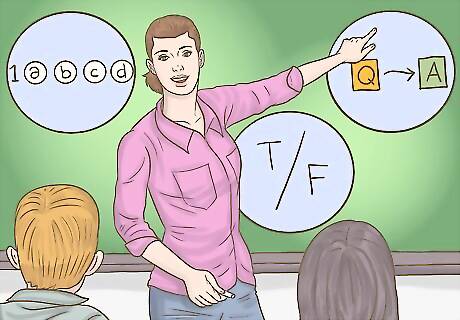
views
Developing a Rubric

Define a specific learning objective for each unit, test, and project. Create a concise objective that summarizes the subject matter, skills exercised, and learning goals. Define the skills students will develop with measurable, actionable verbs. Include details that tailor the objective to the subject matter of a specific unit or assignment. A strong objective for a unit would be, “Students will identify and describe the key players and events of the Second World War’s European and Pacific theaters.” A strong objective for a project could be, ”Students will analyze the wartime strategies of 1 Allied or Axis nation.” Weak objectives would be, “Students will learn to communicate clearly,” or “Students will understand the causes, players, and events of World War II.” The first example isn’t specific, and “understand” isn’t as measurable or actionable as “identify,” “describe,” and “analyze.”

Identify the assignment’s key concepts or skills. Break up the learning objective into specific criteria that students should meet. Use simple, age-appropriate language for these and other descriptions. List these concepts or skills in the rubric’s first column. Key concepts or skills could include subject knowledge, comprehensiveness, organization, use of reliable sources, and spelling and grammar.

Create clear standards instead of vague, general guidelines. Develop at least 3 performance levels for each key concept or skill. Include details that relate to the specific concept or skill instead of generalizations, such as “Advanced” or “Proficient.” Assign points for each performance level, and list levels in rows to the right of each concept or skill. Performance levels for a subject knowledge category could be: 3 points: Student demonstrates accurate, detailed knowledge of the nation and its wartime strategies. 2 points: Student identifies and explains key information, but omits some details. 1 point: Student presents basic facts with little detail throughout. 0 points: Student provides inaccurate information and omits basic facts.

Provide examples of excellent, good, and unsatisfactory work. Giving students a rubric ahead of time lets them know exactly how you’re evaluating them. Additionally, show them past projects, papers, or tests so they know what various levels of quality look like.

Adapt rubrics to students’ age level. For younger students, use age-appropriate language to teach them about rubrics. Simplified key concepts and performance levels can help them learn how to meet expectations. Simpler performance level descriptions for young students could be: Student can name the 7 continents with no hesitation. Student can recite multiplication tables for the numbers 1 through 10. Student always writes their tasks in their assignment pad.
Incorporating Multiple Evaluation Tools

Assign 1-minute papers at the end of class sessions. Ask students to write a paragraph about what they found to be the lesson’s most important concept. You could also have them write about something in the lesson they didn’t understand. Daily 1-minute papers can help you evaluate learning on a class-by-class basis. If you find several students are confused about the same topic, review that topic during the next class.

Format quizzes and tests to fit the unit’s learning outcomes. Tests and quizzes are usually the most direct evaluation tools, so your formatting choices must target the subject matter strategically. From multiple choice questions to long essays, there are a variety of formatting options. Typically, including a mix of problems is the best way to assess both factual and conceptual knowledge. For instance, cover lots of information with multiple choice and other objective questions. Assess how well students grasp overarching concepts with short answers and essays. Break up dense units with several quizzes to measure comprehension 1 concept at a time.

Use objective problems to cover wide ranges of information. Objective problems include multiple choice, true or false, and matching questions. These are best for assessing factual knowledge, such as dates, vocabulary, definitions, and logical reasoning. Objective problems are easy to grade, but take the longest to create. They also encourage guessing and primarily measure a student’s ability to recall information. For multiple choice questions, make sure all possible answers are grammatically consistent with the question.

Include word problems on math and science tests. Math and science tests typically involve numerical or logical problems. Including real-world applications varies the test’s difficulty and measures students’ conceptual grasp of a mathematical operation. An example problem could be, “A real estate agent makes 6% commission on a home sale. If the commission is $9,750, what is the home’s selling price?” Additionally, try to include word problems with multiple steps: “Sam bought 3 cars at $5,000 each and 2 cars at $7,500 each. He sold each car for 7% more than the price he paid. How much profit (in dollars) did he make on each car, and how much profit did he make overall?”

Assess comprehension and writing skills with essays. Short and long essay questions are the best ways to evaluate a student’s understanding of a unit’s key concepts. Short, paragraph-long essays can cover a wider range of information, while long essays focus on a unit’s overarching themes. Include actionable verbs, such as, “Identify and explain the main causes of the Second World War,” or “Describe the roles nationalism and militarism played in German and Japanese foreign policy in the 1930s.” For subjects such as history, social studies, and language arts, including a mix of objective, short answer, and essay questions balances factual recall with conceptual understanding. Essay questions are easier to create, but take longer to grade.

Include long-term projects to assess independent learning skills. Long-term projects include research papers, oral presentations, and scientific experiments. Assign a long-term project to assess initiative, independent research, and creativity. These assignments are also useful for evaluating specific skills, such as constructing an argument, public speaking, or following the scientific method. Break up long-term projects into check points. Use first drafts to evaluate progress and offer feedback. Since they’re opportunities to identify mistakes, first drafts should be ungraded or carry a low grade weight.
Grading Students Fairly

Use graded assignments to assess and ungraded work to develop skills. Tests, quizzes, and projects fall into the category of summative assessments. These are formally graded assignments and are the main way teachers evaluate student learning. Formative assessments, such as homework, are the tools teachers use to develop required skills and knowledge. Since they're opportunities to learn from mistakes, avoid formally grading homework assignments. Give credit for completing homework assignments, but don't count wrong answers against their grade. Factor their overall homework score into their final grade. For instance, they completed 38 of 40 assignments, and homework is 20% of their final grade, they get 19 out of 20 points. EXPERT TIP Joseph Meyer Joseph Meyer Math Teacher Joseph Meyer is a High School Math Teacher based in Pittsburgh, Pennsylvania. He is an educator at City Charter High School, where he has been teaching for over 7 years. Joseph is also the founder of Sandbox Math, an online learning community dedicated to helping students succeed in Algebra. His site is set apart by its focus on fostering genuine comprehension through step-by-step understanding (instead of just getting the correct final answer), enabling learners to identify and overcome misunderstandings and confidently take on any test they face. He received his MA in Physics from Case Western Reserve University and his BA in Physics from Baldwin Wallace University. Joseph Meyer Joseph Meyer Math Teacher Assess students early to identify important knowledge gaps. Struggling students often have unidentified gaps in foundational concepts, leading to poor performance when learning advanced topics. Circumvent this problem by assessing their skills early on, and then filling in knowledge gaps as needed.

Grade tests and projects without reading students’ names. Grading anonymously helps eliminate conscious and subconscious biases. It’s tough to grade handwritten assignments blindly, but you should still do your best to stick to anonymous grading. Blind grading techniques include covering students’ names, having them write their names on the backs of assignments, and having them write assigned ID numbers instead of their names.

Read a few assignments before you grade if the rubric is subjective. Start by sampling about a quarter of essay tests or research papers. If you’ve collected 25 essays, skim 5 or 10. This will help you get a feel for the quality range of the assignment you’re grading.

Grade tests 1 essay or section of problems at a time. For essay tests, read and grade the first essay on all the tests, then grade the second essay. For other test formats, grade each section 1 at a time. Grading item-by-item will help you keep each section’s criteria fresh in mind.
Offering Supportive, Constructive Feedback

Give feedback as soon after a due date as possible. Students might not use your comments constructively if too much time passes between the due date and getting feedback. Tell them when to expect a graded test or paper ahead of time. While the workload can be hard to manage, do your best to stick to your deadlines. For example, let them know that you’ll have their graded papers back to them a week after the due date. If you're tutoring a student one-on-one rather than evaluating students in a classroom, make sure you know the expectations of where the student wants to be and (if applicable), where the parents want the student to be as well. This can influence the timeline of your feedback.

Praise specific efforts, behaviors, and strategies. Instead of praising qualities, such as intelligence, mention specific actions that you want to reinforce. Positive feedback that focuses on qualities can encourage high performers to rest on their laurels. For example, say or write, “This is a thorough, detailed explanation, and it shows you’ve done a lot of research. Keep up the hard work!”

Suggest ways to improve instead of just pointing out weaknesses. Balance positive and negative feedback, and encourage students to improve themselves. Mention places where a student did well, and tell them how they could apply those successful strategies elsewhere. For example, tell them, “Your class participation is strong, and I can tell you always do the assigned reading. However, your essays didn’t include much supporting evidence. Try jotting down each reading’s key points and review them when you study for the test.” EXPERT TIP Joseph Meyer Joseph Meyer Math Teacher Joseph Meyer is a High School Math Teacher based in Pittsburgh, Pennsylvania. He is an educator at City Charter High School, where he has been teaching for over 7 years. Joseph is also the founder of Sandbox Math, an online learning community dedicated to helping students succeed in Algebra. His site is set apart by its focus on fostering genuine comprehension through step-by-step understanding (instead of just getting the correct final answer), enabling learners to identify and overcome misunderstandings and confidently take on any test they face. He received his MA in Physics from Case Western Reserve University and his BA in Physics from Baldwin Wallace University. Joseph Meyer Joseph Meyer Math Teacher Effective teaching strategies consider a student's individual strengths. Tailoring instruction to a student's existing skills and encouraging collaborative activities can improve a student's outcome. Recognizing diverse learning styles allows for a stronger approach, fostering potential in all learners.

Avoid giving unfocused, sarcastic, or vague feedback. Instead of “Not exactly,” “Clarify,” or “Expand,” try to make your comments as specific as possible. Say or write, “This description isn’t precise. Review chapter 4, pages 155-160,” or “Cut your thesis to 1 to 2 lines, and avoid using adverbs to fluff up your argument.”


















Comments
0 comment